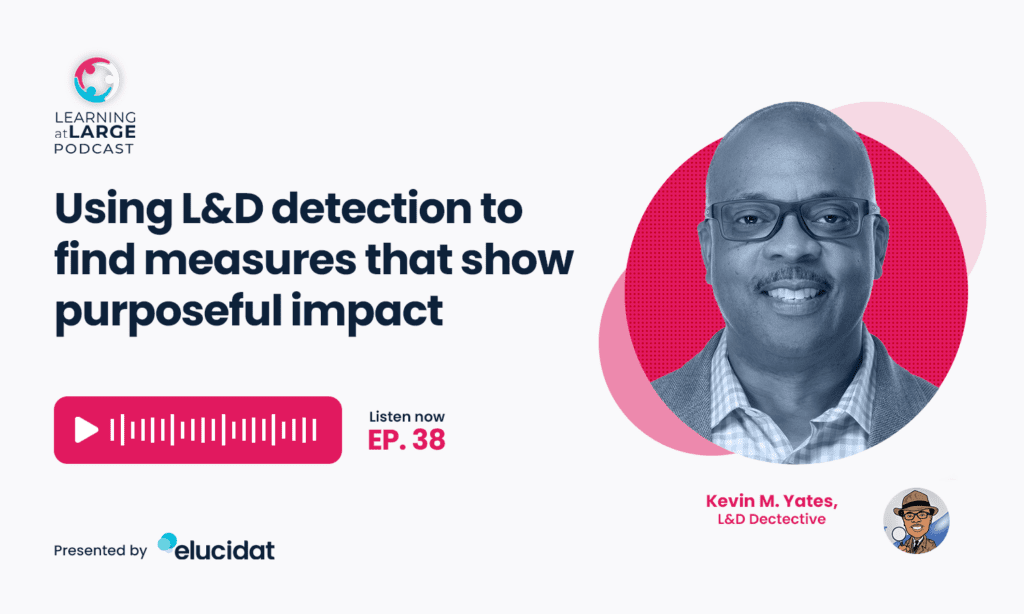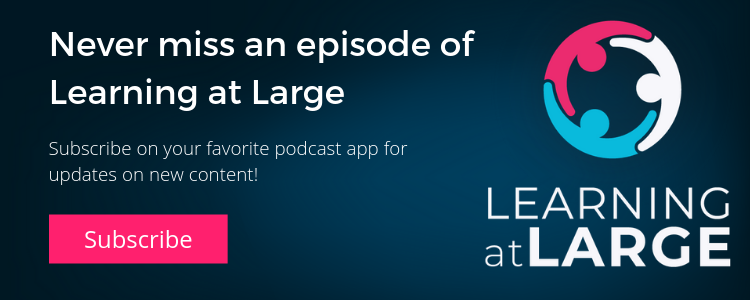L&D Measures That Show Impact: Kevin M Yates
L&D is all about creating change. But how do you know if you’ve successfully achieved this? Hear why Kevin M. Yates, L&D Detective, believes everyone can uncover the learning measurements that count. Find out when to measure and what to look for. Discover why refocusing the business on purpose is essential to creating impact.

Top tips to make sure you’re measuring purposeful impact
Don’t have time to listen now? Here are some top tips from Kevin:
- Look for signals of change: Although tricky, measurement and evaluation are possible. Instead of looking for concrete proof, search for signs of your impact.
- Be strategic about what you measure: Don’t evaluate every project. Focus your time and resources on measuring the initiatives that matter most.
- Consider measurements from the start: Plan and proactively define your training impact from the beginning. Don’t let measurement be an afterthought.
- Step out of an order taking role: L&D teams are under pressure to deliver. Instead of rushing ahead, discuss the training purpose with your business.
1. Look for signals of change
Measurement and evaluation have always been seen as a challenge for L&D teams. When it’s done, it can be inconsistent and vary in quality. More often than not, it’s not done at all.
Although it can be tricky, Kevin wants to reinforce that measurement and evaluation is possible. You just need to rethink what you’re looking for. Instead of searching for that elusive measure that will show your learning initiative to be solely responsible for change, look for a signal.
“When it comes to measuring the impact of training, [it’s about] being able to get a good signal of the extent to which learning has influenced behavior, actions, habits, performance, and business outcomes…The data, evidence or facts show that this happened, not just because of training, but because training was part of an overall strategy.”
2. Be strategic about what you measure
Faced with ever increasing training demands, it’s not surprising that measurement and evaluation tends to slip down the L&D to-do list. It requires time, resources and budget. All of which can be in short supply.
That’s why Kevin takes a strategic approach to measurement and evaluation. He explains that you don’t need to measure the impact of every learning solution. For compliance courses where 100% completion is the aim, it’s fine to leave it there. Focus your time and resources on measuring the impact of learning initiatives that matter most to your organization.
“I think about whether or not there are clear performance outcome. I think about whether or not it has executive sponsorship or visibility. I think about whether or not there is high costs attached to developing and delivering that program. Those are just three things that are top of mind when we want to go for end-to-end measuring impact.”
3. Consider measurements from the start
When to consider measurement is just as important as what to measure. But L&D teams can often take a post mortem view of measuring impact. They’re designing and delivering a solution and seeing what happens.
For Kevin, it’s vital that you don’t wait on this. Training impact needs to be planned and proactively defined from the beginning. Think about the outcome before anything is designed, shipped, utilized and consumed. Otherwise, you’re just throwing darts in the dark.
“Prior to designing a training and learning solution, let’s have the conversation about the intention. Let’s have a conversation about the purpose. And then let’s define what purpose fulfilled look like. If we can define what purpose fulfilled looks like, we can measure the extent to which purpose was fulfilled.”
4. Step out of an order taking role
From instructional design to program management, Kevin has played a number of L&D roles over this career. He understands the pressure teams are under. When the business comes to L&D with an urgent training request, it can be easy to run ahead and start designing a solution. But how do you know what an effective solution looks like?
Kevin wants L&D to step out of an order taking role. Have conversations with the business about purpose and intention. Without doing that, your measurement and evaluation can’t be effective.
“Talk to me about what’s driving this need. Talk to me about where we are today versus where we need to be. Talk to me about what you’re seeing or observing in terms of performance gaps. Talk to me a little bit more about what happens if we aren’t able to achieve the goal? What are the risks?…It’s a different mindset. It’s a different conversation on both ends because, more often than not, we used to that order taking process.”
A quick recap
Too often an afterthought for L&D, Kevin has four strategies to find measures that show purposeful impact.
- Instead of looking for concrete proof, search for signals of change
- Be strategic rather than trying to evaluate every learning solution
- Proactively define your training impact from the beginning.
- Move from order taker to a business partner with purpose
Want to find out more? Check out the full podcast.
About Kevin
Starting out in L&D over 20 years ago, Kevin has worked in a variety of learning technology roles in a number of industries. He’s a passionate advocate for measuring the impact of training, learning and talent development.
You can find out more and get connected with Kevin M. Yates on LinkedIn.
On Kevin’s reading list
Find out where you can explore Kevin’s approach to measurement and evaluation in more detail.
Kevin’s L&D Detective Kit for solving impact mysteries shows you how to evaluate your learning solutions. Packed with templates, it gives you the tools you need to succeed in measurement and evaluation.
Looking for more reading tips? Check out our book blog.
Join the conversation!
We’d love to hear your thoughts on our podcast, so feel free to email Kirstie, our podcast host, at kirstie.greany@elucidat.com. As always, don’t forget to subscribe to Learning at Large in your favorite podcast app and leave us a 5-star rating if you enjoyed it. Thank you for joining us, and see you next time.
